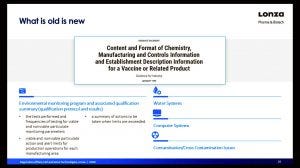- Sponsored Content
Meeting Regulatory Requirements for Cell and Gene Therapy ManufacturingMeeting Regulatory Requirements for Cell and Gene Therapy Manufacturing
August 28, 2020
Sponsored by Lonza Biologics
 Karen Magers, head of regulatory affairs, cell and gene technologies; and Rajesh Thangapazham, head of regulatory strategy, cell and gene technologies, Lonza Pharma and Biotech
Karen Magers, head of regulatory affairs, cell and gene technologies; and Rajesh Thangapazham, head of regulatory strategy, cell and gene technologies, Lonza Pharma and Biotech
Magers began with an overview of the complex regulations and guidance applicable to makers of cell and gene therapies. A slide illustrated the development timeline of such therapies and their associated regulations and guidance documents. That framework continues to evolve through revision of documents and guidelines as more information is gained about the technologies and their development pathways.
She highlighted important regulatory documents establishing guidelines on good manufacturing practices (GMPs) for advanced therapy medicinal products (ATMPs) and laying out chemistry, manufacturing, and controls (CMC) information for human gene therapy investigational new drug (IND) applications. Magers outlined regulatory pathways and designations of programs available to sponsors seeking accelerated steps toward development and approval. Along with the US Food and Drug Administration (FDA) breakthrough, fast-track, and accelerated-approval pathways, a newer program offers guidance for development of a regenerative medicine advanced therapy (RMAT). European guidelines offer accelerated designations for therapies addressing unmet medical needs through a conditional marketing authorization and a priority review/assessment.
Many developers of such products pursue orphan drug designations. She noted that one of the biggest challenges in the CMC space for regenerative medicines is the timing and execution of CMC development for expedited programs. Because the goal is to ensure that therapies for serious conditions can be made available to patients as soon as possible, many development timelines are accelerated in such a way that CMC and GMP issues are on the critical path. With no quality compromises allowed, sponsors must work closely with health authorities to understand and avail themselves of opportunities for flexibility. Postapproval CMC efforts are expected.
Aseptic processing is one regulatory hot topic. Because processing steps use closed systems, open steps need to take place in biological safety cabinets, for which regulators will want assurance of proper cleaning and line clearance between product batches. Regulators want demonstrated design and execution of disinfectant effectiveness studies and data interpretation. Risk assessment must be performed every time a new product is brought into a facility to assess whether existing control strategies prevent contamination adequately. A manufacturer might be handling products based on different technological modalities (for example, different types of viral vectors for different types of programs) within one facility.
Regulators want to know what other products are manufactured in a facility, with easily readable diagrams showing the flow of product, personnel, equipment, waste, and air and identifying intersections that might pose risks. They need to see information about heating, ventilation, and air conditioning (HVAC) systems, the number and segregation of air-handling units, air changes per hour, and air pressure and differentials between adjacent areas. Regulators are keenly interested in a company’s environmental monitoring programs and want validation details about water systems and computer systems.
Thangapazham took the podium to describe the Lonza’s regulatory support mechanism for sponsors. The company advises its clients on strategy development during process development and technology transfer. Early stage clients appreciate help navigating the regulatory landscape concerning import/export of critical raw materials, animal-origin materials, and drug substance and drug products. The company helps its clients procure essential permits and licenses for ensuring compliance. Strategic and technical support includes creation of briefing documents, participation in meetings with regulatory authorities, and responses to information requests from regulators during application review processes. Postapproval support includes providing annual product reviews, updating master files, and assisting with postapproval changes. Regulatory documentation is provided in common-technical-document format and is submitted electronically to relevant regulatory agencies.
Thangapazham spoke at length about regulations for drug master files (DMFs), a regulatory mechanism to provide companies’ confidential and proprietary information directly to the FDA. DMFs support clinical and commercial applications.
Watch the complete presentation now.
You May Also Like






